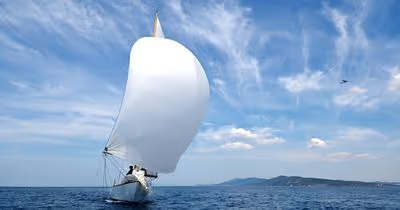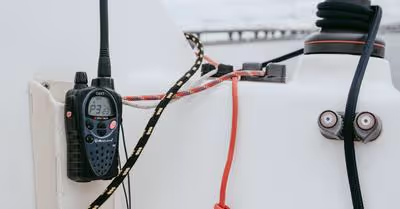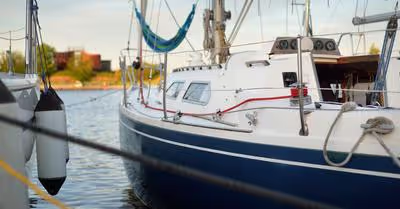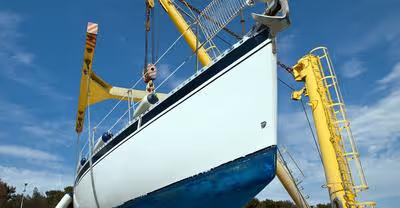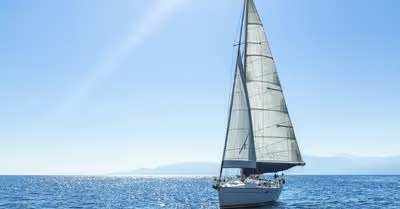Table of Contents
Learn the Language of Sailing
Speaking of covering the basics when it comes to sailing, you need to get familiar with the terms used in sailing. Some of the terms used to describe sailboats, sails, and how to operate them date back to the old days. So there is some terminology to learn to define the different parts of a sailboat and its sails, as well as maneuvers and directions a sailboat may sail.
For example, because there is no angle for the wind to contact the sails and fill them, a boat cannot sail directly into the wind. As a result, the sails will flutter away from the wind like a flag, preventing the boat from moving ahead. This is known as being "in irons," and it refers to a prisoner who is unable to move his or her legs or arms due to large iron cuffs. In this case, it refers to a boat that's in one place, unable to move because of the wind.
Get Enrolled
Sailing alone as a novice is no joke, but if you're planning to sail around the world, you will need the right training and the right training instructor. Once enrolled, you should be given a textbook and taught by a US Sailing or ASA licensed and qualified instructor. It's also useful if the boat you're learning on has all or at least most of the new technologies that are required to get you back home safely.
Some of the best sailing schools out there divide the training courses between classroom studies and practicing on an actual boat. It is important to choose a sailing school that can offer its students the best of both worlds. The good news is, you can easily find sailing schools near you, especially if you're living in a town that's home to avid sailors.
Where to Learn
One of the most effective ways to learn to sail is to do it while on vacation. This is because you will be far away from your daily work routine and everyday distractions that can keep you from picking up the essential sailing techniques. Find a spot that's near a huge body of water, such as the Chesapeake Bay, Gulf of Mexico, or other regions with attractive marinas.
Because of the consistent winds of bigger bodies of water, you will be able to practice a variety of movements without running aground. Some training institutions are located in ports or small lakes, which is also good for learning. In general, though, the best places to learn to sail are on rivers and small lakes. Teaching vessels on these canals are often tiny, and the winds can be strong, especially if there are mountains or big structures nearby, so you might want to consider that factor when choosing a location to practice sailing.
Best Time to Learn
When it comes to learning how to sail, the ideal conditions for learning are mostly during the spring and fall season. This is because the winds tend to be quiet from late morning through the afternoon during the summer heat when breezes from warm coasts over cooler seas start to kick up.
There is always lots to learn, despite the wind conditions, and these conditions are ideal for first-timers. There are also many sailing schools that cater to individuals who want to learn while on vacation, in which case, any time is a good time.
However, if you reside in northern climes and want to take lessons close to home, it all depends on when sailing schools in your region are open for business.
Choosing the Right Boat
Choosing the sailboat for your journey is going to be critical to your success and safety. For instance, small centerboard dinghies or even catamarans are ideal for learning. So, you may be asking, "What is a dinghy with a centerboard?"
That's an open cockpit boat with only one sail that's suited for one or two persons to sit in. When a sail catches wind, the boat learns to turn in the other direction and requires weight beneath the hull (the portion of the boat where you sit or stand) to resist the wind's power.
When the vessel "heels" in sail-speak, you lower the centerboard to protect the boat from capsizing. You can also try a keelboat to get started. A keelboat is a type of sailboat with a fin-shaped protrusion (typically made of lead) attached to the hull's bottom. In a keelboat, the keel is forced to elevate in the opposite direction of the sails whenever the sails fill with air and the boat heels or leans over.
The keel helps to prevent the vessel from leaning over too much and filling with water. This is mainly because the keel has weight and always wants to stay down in the water. No matter how hard you try, sailboats like the Colgate 26 are intended not to capsize. But it's not only this which is responsible for balance; it's also how you handle the sails, which is a crucial part of learning to sail. This is referred to as "trimming" the sails. Beginners will also get to learn when it's the right time to let the sails out, which allows some of the wind to escape the sails and lowers the pressures that cause the boat to lean over.
You'll also want to learn how to move quickly, and some older sailboats lack the traits that truly get your blood pumping when the sails are adjusted for speed. Without getting too technical, remember that part of the joy of learning to sail is being on a sailboat that is comfortable, fast, and highly safe, with enough seats for you and the teacher.
The Cost
This basically boils down to how badly you want to sail and how quickly you want to get out there on the open ocean. You can definitely get a one or two-hour class for $45 to $75 per hour, or even less. However, in order to genuinely "learn" how to operate a sailboat, you need to consider the many possibilities available. Some schools offer weekend or shorter courses for under $300, while others charge much more.
However, the bottom line is that you get what you pay for. A vacation package includes your course fees, textbooks, and accommodations. Some of the most recommended sailboats for beginners include the Sprint 15, the Dart 18, and the Catalina 27.
Don't Break the Law
Learning maritime regulations and road rules is a crucial component of being a sailor. Just like you must learn the regulations of the road while learning to drive a car, you must also understand the rules of the sea. It's critical to understand who has the right of way, how to signal for aid, and how and when to assist others. Besides, learning maritime rules and regulations is not only a safety requirement but also a legal requirement as well.
Recent Articles





